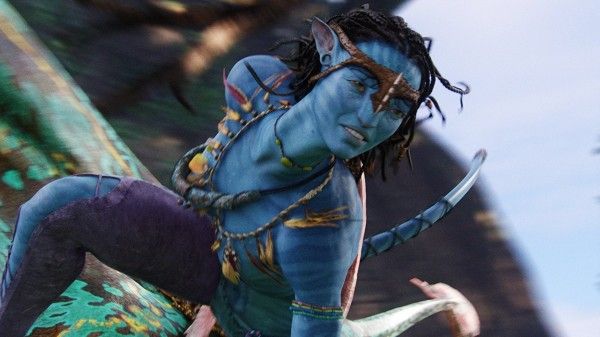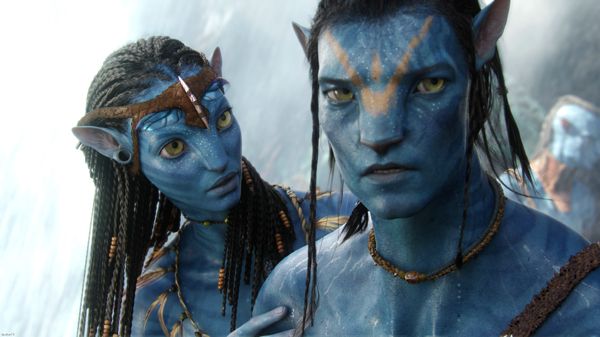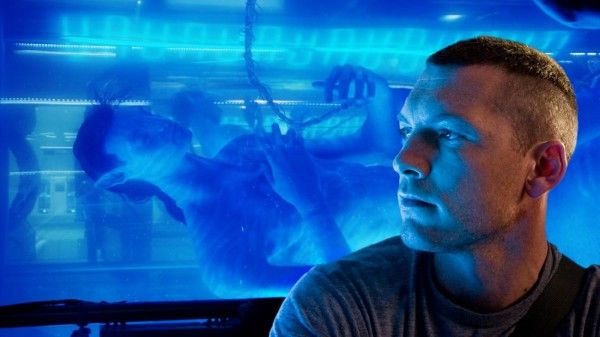THis week marks the tenth anniversary of James Cameron’s history-making blockbuster Avatar, the movie about upsettingly sexy blue elf giants living in space. The science fiction epic featured bleeding edge special effects, most notably an unprecedented 3D experience, and was the first movie to gross over $2 billion worldwide. In fact, Avatar very nearly crossed the $3 billion line, and became the highest-grossing film of all time, a title it held for a decade until Avengers: Endgame (just barely) unseated it earlier this year. You don’t make that kind of money nowadays without being based on a pre-existing property, and Avatar is technically an original story. (Cameron has been hit with numerous lawsuits over his potpourri script, and critics have pointed out that the film borrows from virtually every science fiction story ever written, as well as white savior movies like Dances WIth Wolves and The Last Samurai.)
Cameron wrote the initial treatment for the film way back in 1994, and it was initially planned to be an immediate follow-up to Titanic. (Emphasis on “immediate.”) It still technically is, because Cameron didn’t direct any other feature films in between Titanic and Avatar, but Avatar was supposed to be released in 1999, a window it missed by exactly 10 years. I’m trying to imagine a universe in which Avatar was released the same summer as Deep Blue Sea and my brain simply will not allow it. Also, in a move that became the template for the next two decades of his career, Cameron announced his plans for Avatar in 1996 before he’d actually finished making Titanic, a film that itself went on to face infamous delays. The cycle of promising more Avatar and then pushing Avatar further and further back is Maximum James Cameron and will likely be carved into the side of the gyroscopic underwater crypt that eventually houses his bones.
Cameron put the movie on hold to make a bunch of documentaries about his arch-nemesis the sea while simultaneously working to refine the motion-capture technology he thought was necessary to realize his full vision for Avatar. And the motion capture rigs used in the completed film are undeniably impressive - they allowed Cameron to capture the actors’ full physical performances, including facial expressions, from several angles at once, resulting in mind-blowingly realistic portrayals of the alien Na’vi. (Well, as realistic as a bunch of blue Slender Man Thundercats can be, anyway.)
Avatar was a big risk for 20th Century Fox, and the studio didn’t finally greenlight Cameron’s wildly ambitious project until Disney nearly swooped in and plucked it away from them in an act that has only grown more ironic with age, sort of like a bottle of wine made out of the California Raisins. And while the official production budget of Avatar was $237 million with an additional $150 million of marketing, some estimates placed the budget as high as $310 million. But obviously it all paid off, as Avatar became the biggest hit of all time. Plans immediately went into motion to turn Avatar into a full-blown franchise to hang right alongside Star Wars and Harry Potter (and now Marvel) in the Pantheon of billion-dollar properties. Fox contracted Cameron to make two sequels in a deal that eventually expanded to an astonishing four movies. Additionally, Cameron announced he was writing an “epic” prequel novel, and that science fiction novelist Steven Gould would be penning a series of four standalone books to expand the Avatar universe. And in 2011, Cameron’s Lightstorm Entertainment and Fox made a deal with Disney to open a series of Avatar attractions in Disney’s theme parks, which included a full-blown Avatar land in Walt Disney World.
Well, it’s been ten years, and we haven’t seen any of those things. Bizarrely, the only piece of the proposed franchise that has actually come to fruition is the Avatar land in Walt Disney World. Called Pandora - The World of Avatar, the 12 acre area of Disney’s Animal Kingdom in their Orlando Disney World resort finally opened in 2017. You can almost hear Disney CEO Bob Iger’s teeth grinding, because that deal was made before the company owned Star Wars, and boy you can bet he wishes they had used all that space to make a Star Wars land. Incidentally, Disney has no immediate plans to make any more Avatar attractions, even though the deal they struck totally gives them the option to do so.
How did we get an Avatar theme park before even a single one of those spinoff novels? You’d think it’d be easier to write 300 pages about spindly cat warriors going on adventures on their distant jungle planet, but Cameron hasn’t even been able to get those off the ground. It’s already been ten years since the film’s release, and the first of its proposed sequels isn’t even due in theaters until 2021, a full 12 years after absolutely everyone on the planet stopped talking about Avatar.
Think about it - how many conversations have you had about Avatar over the past decade? How many people have you seen dressed up as any of the film’s characters at a comic convention or a Halloween party? How many Avatar video games have you played? How many people attend midnight screenings of Avatar? How many times has Avatar been referenced in other areas of pop culture over the past decade? (And I’m talking about references made outside of the initial period of Avatar’s release.) Have you literally ever seen anyone wearing an Avatar t-shirt? The Avatar franchise is, to date, entirely theoretical. All of the proposed sequels, novels, and even the completed theme park (which will never not blow my mind) are based on a single film. A mere 161 minutes of celluloid.
Compare that to the success of any other franchise, like Star Wars or Harry Potter or Marvel. Or, more tellingly, compare that to the success of Cameron’s previous record-breaking blockbuster Titanic. Titanic was everywhere. It stayed in theaters for 10 damn months. “My Heart Will Go On” was the “Let It Go” of the late 90s. Titanic is still a touchstone pop culture reference - People on the internet still have opinions about that movie, and Rick and Morty did an entire freaking episode about Titanic in 2014. It’s had a few major theatrical re-releases, including a fully 3D version in 2012 and a 20th anniversary run in 2017. You can do the “I’m the king of the world!” bit in any random public place, and more than half of the people there will understand the reference. (However, unless the public place in question is the bow of a ship, they will be less clear on why you are making the reference.)
Titanic wound up enjoying a nearly-identical reception to Avatar, and was likewise the highest grossing movie of all time for just over a decade. So why does this film continue to resonate, while Avatar has had the staying power of a carton of McDonald’s french fries? I have some theories. Obviously, Avatar is not a bad movie - you don’t make nearly $3 billion worldwide by being a huge piece of shit. There’s just nothing particularly remarkable about it, ten years later. When I think back to the height of Avatar’s popularity, during its initial theatrical run, every recommendation I heard was based on the film’s technical achievements, like “You have to see this movie in 3D, it’s the most amazing experience you’ll have in a theater.” Many positive write-ups about the film from back then echoed some version of that statement. And the experience of seeing it in the theater, in 3D, just doesn’t translate into a film with any staying power. There’s nothing to talk about. Nobody’s debating the choices of Jake Sully, or discussing theories about the history of the Na’vi. All of the actual story elements of Cameron’s undeniably impressive technical marvel were so derivative of everything that came before it that it wasn’t able to forge its own identity in people’s collective imagination. It didn’t bring anything new to the table of science fiction and fantasy. It’s like trying to remember the story of a theme park ride. You can't be bothered, because the experience was about the ride, not the story. And even though Avatar was also a big success on Blu-ray, you just can’t duplicate that ride at home, even if you were one of those ridiculous people who bought a 3D television.
Avatar perfectly embodies the word “anomaly.” Not only was its earth-shattering success extremely unlikely, but it managed to capture the attention of an entire world of moviegoers who subsequently forgot about it almost immediately. When Avatar 2 finally explodes into theaters in December of 2021, 12 years removed from the success of the original, it’s hard to imagine that anyone is going to give a shit anymore.




